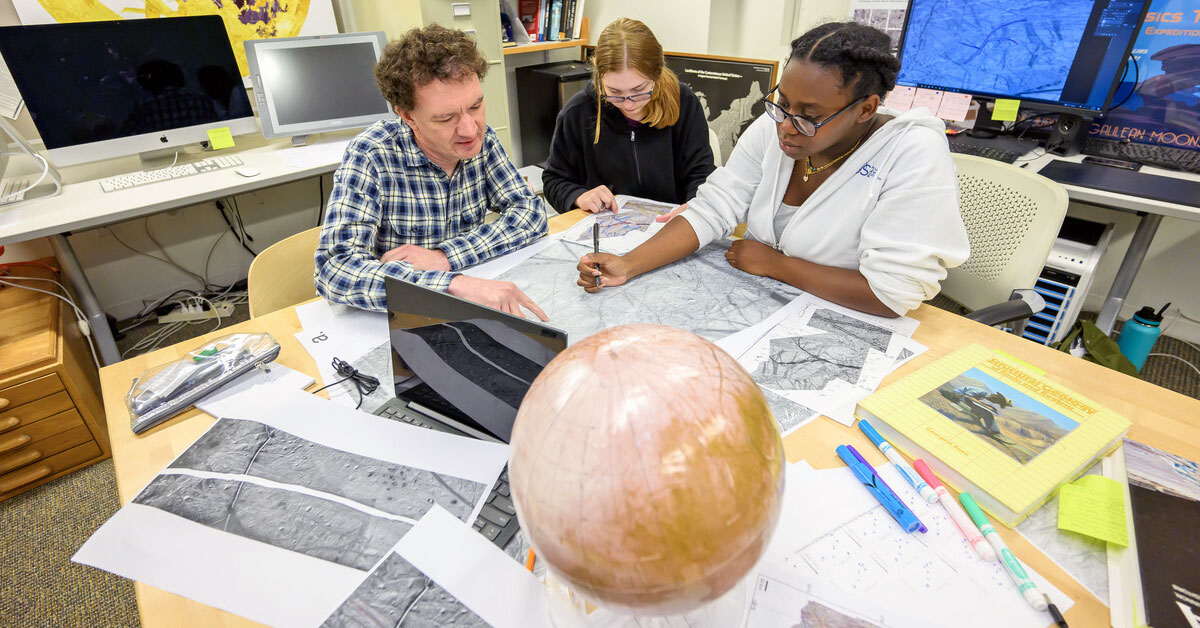Next stop: An ocean world orbiting Jupiter

Professor Collins is a member of the camera team for NASA’s upcoming Europa Clipper mission
As NASA’s much-anticipated Europa Clipper mission is set to launch on October 10, Geoffrey Collins, professor of geology at Wheaton, will be watching from the launch site in Florida. The spacecraft will take flight on a SpaceX Falcon Heavy rocket, bound for a five and a half year journey to Jupiter’s moon Europa. This ice-covered moon is believed to have conditions that are right for life—but any life would exist in a deep global ocean, under a layer of surface ice that could be more than 10 miles thick.
As a planetary geologist, Collins uses the tools of geology, geophysics and remote sensing to learn about the other worlds in our solar system, including Europa. Collins is a co-investigator on the Europa Imaging System on the Europa Clipper mission, working on the science observation strategy that will guide where pictures are taken of the moon’s surface. He has been heavily involved in the mission from its beginning, including leading the Geology Working Group during the first five years of mission design. “I’m very excited for the launch, it’s the culmination of more than 10 years of work,” he says.
In the past two decades, planetary scientists have come to recognize that there is a class of moons and planets with global-scale bodies of liquid water, which they call ocean worlds. “Life as we know it requires liquid water, and Europa is the crown jewel of the ocean worlds in our solar system,” Collins explains. “With an ocean larger than all of the Earth’s oceans combined, in contact with a rocky seafloor, under a relatively thin layer of fresh and young-looking ice, Europa is covered with bizarre surface features that we don’t understand.” He says the Europa Clipper mission is designed to make dozens of close passes by Jupiter’s moon to investigate whether Europa is habitable. “By the end of the mission we should know where the promising places are that we should investigate further in our search for life,” he says. “Right now we have so little data about Europa that our understanding is stuck somewhere like where Mars science was in the mid-1970s.”
Collins states that the Europa Clipper mission is an important step in the search for life in the universe, and that it may lead to more important steps for understanding the ocean world in the years and decades down the road. “Many of us dream of someday searching for life in Europa’s ocean with a robotic submarine, and the data that Europa Clipper collects will lay the groundwork for making such science fiction dreams a reality in the years ahead.”
Recently, Collins has published research as lead author shedding light on plate tectonics on Europa, which has produced the best scientific evidence thus far to make the case for extraterrestrial plate tectonics in the floating ice shell of Europa. They extended prior work to include a more sophisticated geometric approach, basing their analysis on a global map of Europa created by a Wheaton student from images captured by NASA’s Galileo orbiter in the 1990s.
At least 15 Wheaton students have contributed to the project of determining how plate tectonics has operated on the surface of Europa. “It’s like doing a jigsaw puzzle, except you’ll never get to look at the box lid, you don’t initially know where the edges of the pieces are, and there are strict rules about how to move the pieces around,” Collins warns, but Wheaton students are up for the challenge. The existence of active processes like plate tectonics on Europa’s surface may be important for making its ocean habitable for life.
Collins has also been involved with the initial science results from recent observations of Jupiter’s moons Ganymede and Europa by the Juno mission, and is presently working to determine the thickness of a layer of fluffy ice grains on the surface of Saturn’s moon Enceladus.
